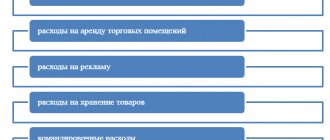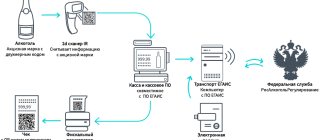Under what conditions can retailers apply UTII?
According to the instructions of paragraphs. 6 paragraph 2 art. 346.26 of the Tax Code of the Russian Federation, representatives of retail trade receive the right to apply the special tax regime UTII (Unified Tax on Imputed Income) provided that the area of the sales area of the store or pavilion in which visitors are served does not exceed 150 sq.m. Let's understand some concepts to make things clearer:
- Article 346.27 of the Tax Code of the Russian Federation defines the concept of retail trade
in relation to the situation with the transition to UTII. Retail trade is a type of business activity, the essence of which is the sale of goods under a retail purchase and sale agreement, incl. using payment cards and in cash. - The same article of the Tax Code contains a definition of a stationary retail chain
. This is considered a building or other structure specially adapted for trading (kiosks, pavilions, shops). - The area of a sales floor
is a part of a premises intended for trade (pavilion, store) or an open area where goods are sold, occupied by equipment used for demonstrating and displaying goods, as well as servicing and making payments (cash, non-cash) with customers. Areas are also taken into account:
- aisles for shoppers;
- cash registers;
- cash registers;
- service personnel workplaces;
- rented portion of the retail space.
Important!
If the owner of a retail chain operates several stores (pavilions, kiosks), it is not their total area that is taken into account, but the retail area of each retail outlet separately. The area of the sales area of each trade facility should not exceed 150 sq.m.
Any area of the store where customer service is not provided is not a sales area.
Warehouses from which goods arrive at the store or are directly issued to the buyer should not be taken into account. Also not taken into account are the areas of premises for receiving, storing and pre-sale preparation of goods, staff premises, utility and administrative premises.
***
So, when conducting retail sales based on samples and catalogs, it is possible to use the imputation mode. However, it is necessary to take into account all the nuances of organizing trade, such as displaying goods, issuing them and storing them.
Similar articles
- When is wholesale trade allowed under the UTII regime?
- Online store on UTII
- Retail trade on the simplified tax system in 2016-2017
- For whom is the cancellation of UTII inconvenient?
- UTII: retail trade in 2021
In what cases should UTII not be used?
Whatever commercial premises the taxpayer uses in his activities, he must have the title and inventory documents drawn up for this facility.
The mentioned papers should reflect the following information:
- Proving the legality of using the outlet. Such information is written down in the following documents: contract of purchase and sale of non-residential premises, plans, explications, diagrams, technical passport, lease (sublease) agreement for the entire retail outlet or only part of it, permission to serve visitors on an open trading floor.
- About the layout, design features, purpose of the object.
In this case, the type of outlet does not matter - it can be a stationary store, a pavilion, a kiosk, a stall, a tent at a fair, a hand cart, a tray, a sales trailer, a point in a shopping center, or a vending machine.
Accordingly, if the entrepreneur does not have the listed documents, it is not possible to determine the status of the premises, and the UTII tax regime cannot be applied.
It will also not be possible to switch to UTII if the area of the retail facility exceeds 150 sq.m. That is, if an entrepreneur maintains a single pavilion with an area of 170 sq.m., UTII cannot be applied. If a businessman owns five kiosks of 90 sq.m. Everyone - UTII is affordable for him.
Trade by samples through stationary retail chain facilities - is UTII applicable?
Despite the fairly extensive list of cases in which it is prohibited to use the taxation system in the form of UTII, there are still cases when this is possible.
Thus, the Ministry of Finance of Russia in its letters dated 03/07/2012 No. 03-11-11/77 and dated 09/21/2012 No. 03-11-11/282 indicated that the use of UTII in its activities when selling products presented in catalogs, as well as in the form of samples, will be justified only if such trade is carried out at the facilities of a stationary retail network. Moreover, the retail outlet’s belonging to such objects must be confirmed by title documents.
See also “Can UTII be used in the retail trade of furniture based on samples and catalogues?”
However, even for such objects there are exceptions. Officials claim that offices, as well as other non-residential premises located in buildings not intended for trade, do not belong to the objects of a stationary retail chain.
Exactly the same point of view is supported by the Presidium of the Supreme Arbitration Court of the Russian Federation, which in its resolutions dated February 15, 2011 No. 12364/10 and dated February 28, 2012 No. 14139/11 indicates that the activities of selling goods according to catalogs and samples, carried out in rented administrative premises buildings does not provide for the use of UTII due to the fact that these premises do not belong to the facilities of a stationary retail chain.
The lower courts justified their decisions with the same arguments (resolutions of the Federal Antimonopoly Service of the Ural District dated June 29, 2012 No. F09-4404/12, Federal Antimonopoly Service of the North Caucasus District dated July 19, 2012 No. A32-10054/2011).
Along with this, the Federal Antimonopoly Service of the North-Western District made a completely opposite court decision. The resolution dated July 18, 2012 No. A05-9497/2011 states that the purchase and payment of goods upon receipt from the seller’s warehouse located in the rented premises of an administrative building is recognized as an activity that can be attributed to the taxation system in the form of UTII. The judges motivated this decision by the fact that such sales of products constitute trade through a pavilion, which in turn is subject to UTII. In addition, the resolution states that the presence of a sample of a product at a retail outlet does not mean the sale of this particular sample, since similar products can be located either elsewhere in the retail outlet or in warehouses.
Expert opinion on the question of whether trading using UTII catalogs is possible
Summarizing all of the above, we can conclude that trade in catalogs can be taxed under a special UTII regime, provided that 2 requirements are met:
- The area of each sales area individually does not exceed 150 sq.m.
- The main part of the trading service is provided on the territory of the trading floor (trading according to UTII catalogs is carried out through specialized stores with subsequent delivery of the goods).
If sales based on samples and catalogs are carried out “outside the stationary network”, without the need to visit the sales floor, then the use of UTII is unacceptable.
Example 1: Retail sale of modular kitchens
A store selling modular kitchens has opened; it operates according to the following principle:
- The client comes to the store and looks at samples of kitchens available for production.
- The buyer places an order at the counter located in the hall.
- The modular kitchen is shipped from the warehouse and delivered to the buyer personally or delivered to the home.
Since the client chooses a product in a store (on the sales floor), where kitchen samples are presented, after which he signs a retail sales contract and pays for the purchased furniture, we can say that the seller provides the main part of the trading service in the store. Accordingly, there are no obstacles to the application of the UTII tax regime.
Example 2. Sale of furniture based on samples outside a stationary retail chain
The store sells prefabricated furniture based on samples. Product samples are located in the entrance building (this room is located in the service area, according to the technical plan). Buyers select a sample, place an order, pay for the goods, after which the furniture is delivered to their home.
Since the sale of goods is carried out outside a stationary retail chain, not on the territory of the sales area, the entrepreneur does not have the right to switch to UTII.
When is UTII acceptable when selling product samples?
The imputator sold goods based on samples and catalogues.
At the same time, customers chose products in the store. Then it was delivered to the buyer directly from the factory. According to tax authorities, such a sale cannot be considered retail for the purposes of applying UTII. The entrepreneur is assessed additional taxes according to the general system. The opinion of the inspectors contradicts the letters of the Ministry of Finance of Russia dated 02/22/12 No. 03-11-06/3/12 and dated 03/31/14 No. 03-11-11/13995. Retail trade transferred to UTII does not include sales from catalogs and samples “outside the stationary retail chain” (Article 346.27 of the Tax Code of the Russian Federation). In the commented case, the buyer’s order, as well as payment, are accepted in the store - an object of a stationary retail chain. This, as the Volga District Autonomous District decided, shows the legality of the imputation. Further shipment of goods from the factory or warehouse and its delivery to the buyer’s address is not the basis for re-qualification of trade. Those who sell samples sometimes have to increase the taxable area. This is the conclusion from paragraph 13 of the appendix to the information letter of the Presidium of the Supreme Arbitration Court of the Russian Federation dated 03/05/13 No. 157. It states: usually for tax purposes the area of the passages leading to the trading floor is not taken into account. The exception is the situation when the aisles are adapted for sales. For example, when samples of goods are displayed there. A document that will protect the right to UTII when selling goods to legal entities
Common mistakes
Error:
An entrepreneur who sells goods through a catalog outside a retail chain submits documents to transfer the business to UTII.
A comment:
If the product is sold outside the territory of a stationary retail chain, the transition to UTII is impossible.
Error:
A businessman owns a network of kiosks selling goods based on samples. He is not making the transition to UTII, since the total area of his stalls is 300 sq.m.
A comment:
The transition to UTII is possible, since the area of each stationary facility is taken into account separately - it should not exceed 150 sq.m.
Answers to common questions about whether trading using UTII catalogs is possible
Question #1:
I have a business selling goods through catalogs. There are small retail outlets throughout the city where visitors are provided with catalogs from where they can choose the product they like, which will be delivered to their home. Payment is made within the boundaries of retail outlets. Is it possible to switch to UTII?
Answer:
Since the main part of the trading service is provided to the buyer within a stationary trading network, the transition to UTII is possible. In your case, trading using UTII catalogs is possible.
Question #2:
I have a store with an area of 130 sq.m. with samples of goods and a warehouse where most of them are stored. Is it possible to switch to UTII?
Answer:
Yes, you have the right to apply UTII, because The area of office premises, which includes a warehouse, is not taken into account when calculating the area of retail space.
Is it possible to use UTII when trading according to samples?
The Tax Code of the Russian Federation provides for the possibility of taxpayers using the taxation system in the form of UTII when carrying out retail trade. At the same time, par. 12 tbsp. 346.27 of the Tax Code of the Russian Federation establishes some restrictions.
Thus, the sale of goods that occurs outside the premises of a stationary trading network through trade through the global Internet, teleshopping, mail, as well as through samples and catalogs, is not recognized as retail trade, and accordingly, in such cases, the use of UTII in these types of activities is prohibited.
For information about who has the right to use the imputation regime in their activities, read the material “Who can apply UTII (procedure, conditions, nuances)?”
This list cannot be called exhaustive, since other restrictions associated with the use of UTII when trading according to catalogs and samples are explained by regulatory authorities. Such restrictions include retail sales of goods carried out by:
- by familiarizing customers with booklets, photographs and other means of advertising goods carried out outside offices and retail outlets (letter of the Ministry of Finance of Russia dated May 28, 2009 No. 03-11-06/3/151);
- through individual or group displays of sold goods at home (letter of the Ministry of Finance of Russia dated April 16, 2008 No. 03-11-04/3/195);
- in the form of presentation of goods in retail premises with subsequent sale and delivery from the warehouse (letter of the Ministry of Finance of Russia dated 03.03.2010 No. 03-11-06/3/25);
- by concluding sales contracts in the office with mandatory delivery of goods to the buyer (letters of the Ministry of Finance of Russia dated June 10, 2010 No. 03-11-06/3/80, dated December 31, 2010 No. 03-11-06/3/175);
- by concluding contracts for sale on the territory of a retail facility with subsequent payment for goods upon receipt at home (letter of the Ministry of Finance dated June 11, 2010 No. 03-11-11/166);
- by accepting applications for delivery of goods by telephone (letter of the Ministry of Finance dated June 11, 2010 No. 03-11-11/166);
- by accepting purchase orders by telephone, without using retail outlets (letters from the Ministry of Finance dated January 27, 2009 No. 03-11-06/3/11, dated September 13, 2010 No. 03-11-1/239);
- through demonstration of goods on websites on the Internet (letter from the Ministry of Finance dated 04/03/2012 No. 03-11-11/111, Federal Tax Service of Russia dated 04/15/2013 No. ED-3-3/ [email protected] );
- by concluding contracts for the supply of drinking water to the buyer both at home and at work (letters from the Ministry of Finance dated March 20, 2008 No. 03-11-05/62, dated November 12, 2008 No. 03-11-04/3/501);
- by delivering drinking water to stores, without using retail outlets in their activities (letter of the Ministry of Finance dated November 12, 2008 No. 03-11-04/3/501);
- according to samples and catalogs of cosmetic products presented by manufacturers (letter of the Ministry of Finance dated January 22, 2009 No. 03-11-06/3/08);
- through a trading terminal with subsequent transfer of goods from the warehouse to the retail outlet for delivery to the buyer (letter of the Ministry of Finance dated December 25, 2007 No. 03-11-04/3/517).







